Scientists have used some surprising and ingenious methods to get Greenshell mussels to breed in captivity and their efforts could soon be worth $200 million a year to the New Zealand economy.
Warm baths and vibrating devices are just two of the clever tricks New Zealand scientists have employed to get the famous – and somewhat shy – Greenshell mussels to breed on cue. The first crop from the SPATNZ hatchery is now ready to harvest and to eat, after years of investigative work in Nelson.
Scientist and SPATNZ boss, Rodney Roberts says it’s taken quite a bit of experimenting to get the mussels to give up their secrets.
‘Normally these mussels breed in the wild and we wait for their babies, known as spat, to wash up on beaches attached to seaweed or land on catch ropes. That made life difficult for New Zealand mussel farmers, who had to cross their fingers and hope they would have enough spat for their farms from year to year,’ he explained.
‘We had to work pretty hard to figure out how to get the Greenshell mussels to breed reliably in our hatchery. We experimented with lighting, different bath temperatures and sounds and we finally settled on a combination of light, temperature and small vibrations that seems to really get the mussels going, encouraging them to produce maximum quantities of sperm and eggs,’ he commented, adding that the process might sound funny, but it has yielded seriously good results.
‘We are now able to produce billions of mussel eggs each month and the great news is that these are growing into strong, faster growing and more consistent mussels.’
Mussel farmers agree. Bruce Hearn, who farms in the Marlborough Sounds and is also the Chairman of Aquaculture New Zealand says he’s incredibly excited about what it means for the industry.
‘There are a lot of aspects to wild spat, it differs in quantity and quality, you never know when it is coming and when you can get it so there is no certainty. One of the advantages of hatchery spat is that we will know when we are getting it and we can plan for it. That will make a huge difference. It may be hard to appreciate just how much difference it will make, but that is a huge advantage on its own,’ Bruce Hearn said.
‘Hatchery spat is a game changer for our industry, it opens up all sorts of opportunities around selective breeding and product development in high value areas like nutraceuticals and superfoods. New Zealand mussels are already world famous but the hatchery unlocks a new level of innovation to take our industry to another level,’ agreed Aquaculture New Zealand CEO Gary Hooper.
The SPATNZ hatchery and the science behind it is the result of a collaboration between the Ministry for Primary Industries (MPI) and New Zealand’s oldest and biggest seafood company, Sanford, through the Primary Growth Partnership.
‘It’s always very satisfying when scientists can say that they’ve done it – they’ve confronted a problem head on in a smart way and they’ve solved it. Sanford is delighted that our mussel farmers will get real and significant benefits from SPATNZ’s hard work,’ said Sanford CEO Volker Kuntzsch.
Sanford and MPI are each investing $13 million into this PGP programme over its lifetime. Sanford and its contract growers will initially benefit from the research and technology but a requirement of this Primary Growth Partnership programme is that in time the technology will be shared with everyone in the industry.
MPI’s Director Investment Programmes Justine Gilliland said that MPI is excited by the progress of the SPATNZ PGP programme and its prospects.
‘The key things that we think are amazing opportunities for the programme are around not only the product in its raw form, those beautiful Greenshell mussels that we all love to eat, but also the opportunity for example, with nutraceutical products,’ she commented.
‘One of the requirements of PGP programmes is that, at the end of the day, the knowledge is disseminated more widely to the industry. We are really excited about the opportunity that the SPATNZ programme presents for the rest of the industry in New Zealand.’
SPATNZ hatchery mussels are at harvest size now in the Marlborough Sounds and close to 500 tonnes of them will be harvested over the coming months.









